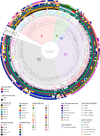Genomic comparisons of Escherichia coli ST131 from Australia
- PMID: 34910614
- PMCID: PMC8767332
- DOI: 10.1099/mgen.0.000721
Genomic comparisons of Escherichia coli ST131 from Australia
Abstract
Escherichia coli ST131 is a globally dispersed extraintestinal pathogenic E. coli lineage contributing significantly to hospital and community acquired urinary tract and bloodstream infections. Here we describe a detailed phylogenetic analysis of the whole genome sequences of 284 Australian ST131 E. coli isolates from diverse sources, including clinical, food and companion animals, wildlife and the environment. Our phylogeny and the results of single nucleotide polymorphism (SNP) analysis show the typical ST131 clade distribution with clades A, B and C clearly displayed, but no niche associations were observed. Indeed, interspecies relatedness was a feature of this study. Thirty-five isolates (29 of human and six of wild bird origin) from clade A (32 fimH41, 2 fimH89, 1 fimH141) were observed to differ by an average of 76 SNPs. Forty-five isolates from clade C1 from four sources formed a cluster with an average of 46 SNPs. Within this cluster, human sourced isolates differed by approximately 37 SNPs from isolates sourced from canines, approximately 50 SNPs from isolates from wild birds, and approximately 52 SNPs from isolates from wastewater. Many ST131 carried resistance genes to multiple antibiotic classes and while 41 (14 %) contained the complete class one integron-integrase intI1, 128 (45 %) isolates harboured a truncated intI1 (462-1014 bp), highlighting the ongoing evolution of this element. The module intI1-dfrA17-aadA5-qacEΔ1-sul1-ORF-chrA-padR-IS1600-mphR-mrx-mphA, conferring resistance to trimethoprim, aminoglycosides, quaternary ammonium compounds, sulphonamides, chromate and macrolides, was the most common structure. Most (73 %) Australian ST131 isolates carry at least one extended spectrum β-lactamase gene, typically blaCTX-M-15 and blaCTX-M-27. Notably, dual parC-1aAB and gyrA-1AB fluoroquinolone resistant mutations, a unique feature of clade C ST131 isolates, were identified in some clade A isolates. The results of this study indicate that the the ST131 population in Australia carries diverse antimicrobial resistance genes and plasmid replicons and indicate cross-species movement of ST131 strains across diverse reservoirs.
Keywords: H41; ST131; blaCTX-M-27; class 1 integrons; extraintestinal pathogenic Escherichia coli (ExPEC); one health; urinary tract infection (UTI).
Conflict of interest statement
The authors declare that the funding bodies had no direct influence on the study design, collection, analysis/interpretation of data, or in the writing of this report.
Figures






References
Publication types
MeSH terms
Substances
LinkOut - more resources
Full Text Sources

